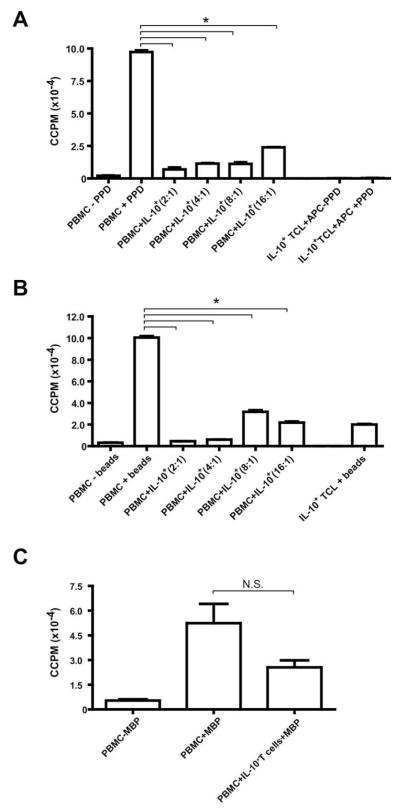Fig. 2.
PPD-specific IL-10+ T cells are anergic and suppressive in a dose-dependent fashion. IL-10+ T cells were selected from human peripheral blood and expanded with PPD, IL-2, and IL-15 for 10 days. Autologous naive PBMCs (1 × 106 cells/condition) were activated in 1-mL cultures in 48-well plates in the presence (+) or absence (–) of (A) 50 μg/mL PPD, (B) anti-CD3/CD28 beads (1.25 μl/106 cells), or (C) 50 μg/mL MBP (after one additional round of restimulation with PPD). 1 × 106 IL-10+ T cells were titrated into wells with naive PBMCs in a dilution series from 5 × 105 cells/well to 6.25 × 104 cells/well in 2-fold dilutions (three PBMCs: one IL-10+ T-cell ratio [1 × 106:3 × 105] used for MBP treatment). IL-10+ T cells (1 × 106 cells/well) were also stimulated with irradiated APCs (3 × 106 cells/well), with or without PPD, or alone with anti-CD3/CD28 beads. At the peak response days (day 7 for PPD; day 4 for anti-CD3/CD28 beads; and day 9 for MBP), 100-μl duplicates were harvested into 96-well plates and pulsed with 0.5 μCi 3[H]-thymidine. Results are expressed as corrected counts per minute (ccpm); error bars represent standard error (SE). TCL, T-cell line. *p < 0.01; NS, not significant. Data for PPD and anti-CD3/CD28 stimulation representative of three experiments; MBP data are from one experiment (one distinct individual donor per experiment).

